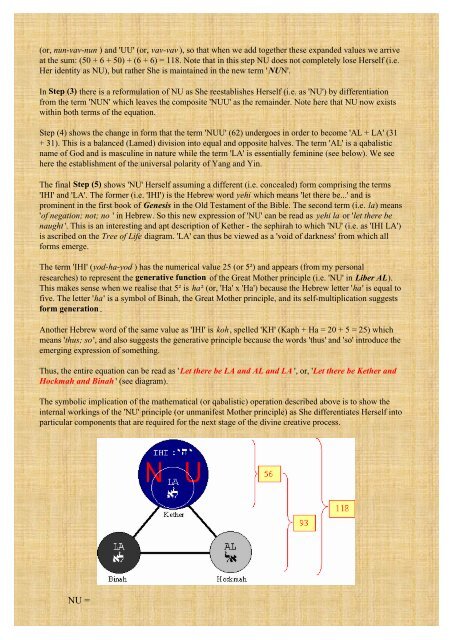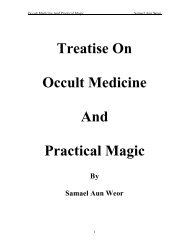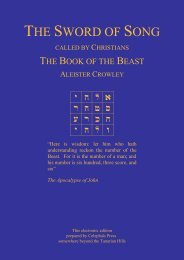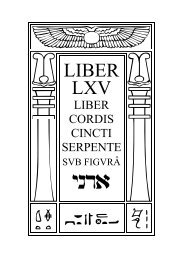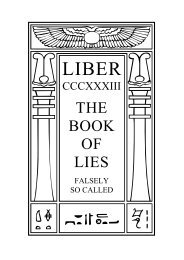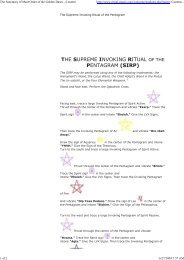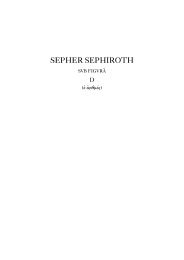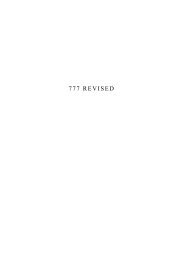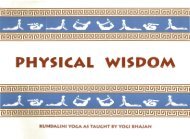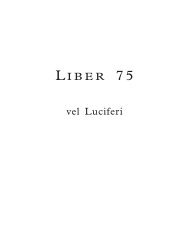Liber Peh (pdf) - Koyote the Blind
Liber Peh (pdf) - Koyote the Blind
Liber Peh (pdf) - Koyote the Blind
Create successful ePaper yourself
Turn your PDF publications into a flip-book with our unique Google optimized e-Paper software.
(or, nun-vav-nun ) and 'UU' (or, vav-vav ), so that when we add toge<strong>the</strong>r <strong>the</strong>se expanded values we arrive<br />
at <strong>the</strong> sum: (50 + 6 + 50) + (6 + 6) = 118. Note that in this step NU does not completely lose Herself (i.e.<br />
Her identity as NU), but ra<strong>the</strong>r She is maintained in <strong>the</strong> new term 'NUN'.<br />
In Step (3) <strong>the</strong>re is a reformulation of NU as She reestablishes Herself (i.e. as 'NU') by differentiation<br />
from <strong>the</strong> term 'NUN' which leaves <strong>the</strong> composite 'NUU' as <strong>the</strong> remainder. Note here that NU now exists<br />
within both terms of <strong>the</strong> equation.<br />
Step (4) shows <strong>the</strong> change in form that <strong>the</strong> term 'NUU' (62) undergoes in order to become 'AL + LA' (31<br />
+ 31). This is a balanced (Lamed) division into equal and opposite halves. The term 'AL' is a qabalistic<br />
name of God and is masculine in nature while <strong>the</strong> term 'LA' is essentially feminine (see below). We see<br />
here <strong>the</strong> establishment of <strong>the</strong> universal polarity of Yang and Yin.<br />
The final Step (5) shows 'NU' Herself assuming a different (i.e. concealed) form comprising <strong>the</strong> terms<br />
'IHI' and 'LA'. The former (i.e. 'IHI') is <strong>the</strong> Hebrew word yehi which means 'let <strong>the</strong>re be...' and is<br />
prominent in <strong>the</strong> first book of Genesis in <strong>the</strong> Old Testament of <strong>the</strong> Bible. The second term (i.e. la) means<br />
'of negation; not; no ' in Hebrew. So this new expression of 'NU' can be read as yehi la or 'let <strong>the</strong>re be<br />
naught '. This is an interesting and apt description of Ke<strong>the</strong>r - <strong>the</strong> sephirah to which 'NU' (i.e. as 'IHI LA')<br />
is ascribed on <strong>the</strong> Tree of Life diagram. 'LA' can thus be viewed as a 'void of darkness' from which all<br />
forms emerge.<br />
The term 'IHI' (yod-ha-yod ) has <strong>the</strong> numerical value 25 (or 5²) and appears (from my personal<br />
researches) to represent <strong>the</strong> generative function of <strong>the</strong> Great Mo<strong>the</strong>r principle (i.e. 'NU' in <strong>Liber</strong> AL).<br />
This makes sense when we realise that 5² is ha² (or, 'Ha' x 'Ha') because <strong>the</strong> Hebrew letter 'ha' is equal to<br />
five. The letter 'ha' is a symbol of Binah, <strong>the</strong> Great Mo<strong>the</strong>r principle, and its self-multiplication suggests<br />
form generation .<br />
Ano<strong>the</strong>r Hebrew word of <strong>the</strong> same value as 'IHI' is koh, spelled 'KH' (Kaph + Ha = 20 + 5 = 25) which<br />
means 'thus; so', and also suggests <strong>the</strong> generative principle because <strong>the</strong> words 'thus' and 'so' introduce <strong>the</strong><br />
emerging expression of something.<br />
Thus, <strong>the</strong> entire equation can be read as 'Let <strong>the</strong>re be LA and AL and LA ', or, 'Let <strong>the</strong>re be Ke<strong>the</strong>r and<br />
Hockmah and Binah ' (see diagram).<br />
The symbolic implication of <strong>the</strong> ma<strong>the</strong>matical (or qabalistic) operation described above is to show <strong>the</strong><br />
internal workings of <strong>the</strong> 'NU' principle (or unmanifest Mo<strong>the</strong>r principle) as She differentiates Herself into<br />
particular components that are required for <strong>the</strong> next stage of <strong>the</strong> divine creative process.<br />
NU =


